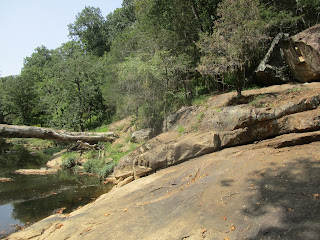Judy and I have been among the "stay-at-homes" during most of the pandemic. But on a fall-like day with low temps and low humidity, we headed to one of our favorite state parks, the Eno River, between Hillsborough and Durham. We first explored this park back in 2013 and this was our fourth visit. This day we tried a new trail and it did not disappoint. Come along for our virtual tour.
Today we ambitiously combined two loop trails, the
Buckquarter Creek and the Holden Mill loops. We had
previously hiked the Buckquarter as well as the Cox
Mountain trail, but the Holden Mill was a new adventure.
How calm the river looked. Recent rains had it normal levels.
These are just a few of a multitude of turtles we saw all
along our trek.
As usual, we saw some beautiful wildflowers that
we couldn't identify.
As we went upriver, the rocks and rapids increased
dramatically. It's the closest thing to a mountain
stream experience that we've found in the Piedmont.
This tree apparently sprouted from an old stump
that had washed downstream.
Another beautiful but unidentified shrub.
This is the largest colony of Wild Ginger I've ever
seen. This is an herb found on our SFL Nature Trail.
Vast swaths of these yellow wildflowers lined our
trail in many areas. Pollinators were everywhere.
If you look closely you'll see two lightning bug
beetles pollinating here. In fact, you may see more
than I see.
This iconic tree appears to be Old Man of the Forest.
He stands as a dark sentinel.
Here's some history on Holden Mill, whose ruins
are the focal point of our second trail.
These carefully laid stone walls and foundations
date all the way back to 1811. Judy's grandfather
operated a mill here in Moore County and my
great-great grandfather ran one in north Atlanta,
so we have an interest in these things.
Note that it was careful design, not cement or mortar
that has these walls still standing.
We had brought a picnic lunch and enjoyed our
meal at this historic site.
We were hungry, of course, but it was also a good
excuse to rest!
We had arrived at the mill, midpoint of our journey,
via the woodland portion of the loop. Now we would
follow the river on the trip back. The brochure said
it was characterized by rapids and boulders, and that
was certainly true.
These days you have to be prepared for "natural detours."
We had to do some rock climbing to circumnavigate
some obstructions to the trail. It was taxing, but we
survived, and that was a source of satisfaction.
Here's another one of my favorites: Resurrection Fern.
It is in its "dry" phase, so obviously it didn't rain so
much there the day before. Also, the trails were not muddy.
Judy's eagle eyes spotted a small snake I had walked
right past. It's a baby hog-nose snake, one of North
Carolina's most interesting.
Non-poisonous and harmless, it is sometimes called
a puff adder. It resorts to mimicry to try to intimidate
potential predators. See how it has spread its "hood,"
to resemble the deadly cobra (which it has never met).
Amanda Loyd Talbert once found an almost identical
snake and called it Connie Cobra, Junior. Remember
that, Amanda?
This is a pretty good example of the giant boulders
that were everywhere.
These placid waters signaled we were almost back
to our starting point.
Just as this sweetgum leaf signaled that autumn
colors are just around the corner.
One more steep set of steps, then a short climb
back to the park office-- and rest rooms!
Foot traffic was fairly light in the park on this Tuesday,
though it was heavier in the afternoon. One thing that
was odd was that at least four groups we encountered
made inquiries of us, since it was their first time ever
at the park. Odd, since we were the ones that drove an
hour and a half to get there. But we were very happy
for those that had discovered this idyllic sanctuary as
we once had. And will continue to rediscover.

































No comments:
Post a Comment